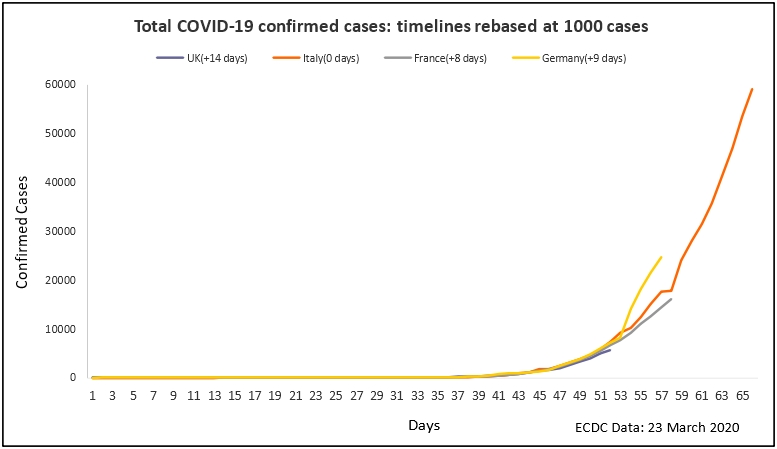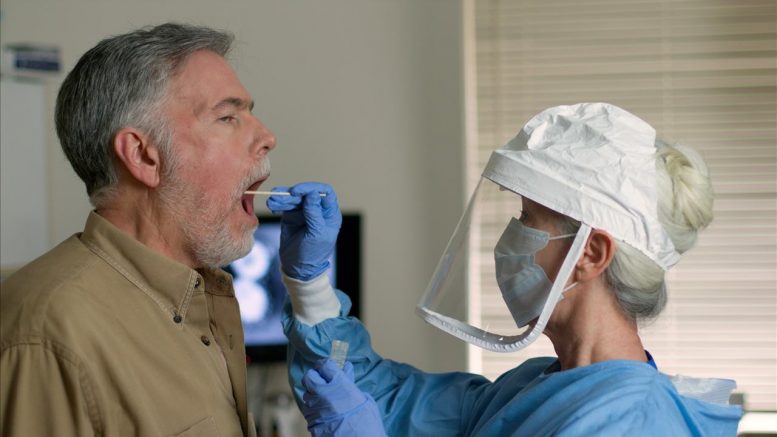The battle to defeat the COVID-19 epidemic is inexorably guided by the laws of mathematics. It is the rate of viral transmission between individuals – and the need to reduce this – that has led to compulsory confinement, John Egan writes in part two of Chief-Exec.com’s series on the pandemic.
Monday 23 March 2020: the day that the United Kingdom finally caught up with Europe and its strategy to deal with the COVID-19 epidemic. After a week in which pleas to the British public to limit their social interactions had fallen on deaf ears, the country has formally gone into lock-down.
Having already been confined for eight days within a Paris apartment, it is striking how similar the journey of both the UK and France has been. While the political incantations of the two leaders – Boris Johnson and Emmanuel Macron – could not have been more different, the reluctant shuffles towards a total shutdown have broadly been the same.
The battle to defeat the COVID-19 epidemic is inexorably guided by the laws of mathematics. It is the rate of viral transmission between individuals – and the need to reduce this – that has eventually led to compulsory confinement.
The power of social distancing – couldn’t be clearer #COVIDー19 pic.twitter.com/qAU0P18uDn
— David Shukman (@davidshukmanbbc) March 22, 2020
In our first article in this series we established a chart to compare the progress of the COVID-19 epidemic between the UK and some of its European neighbours. Shared societal and cultural norms make these nations suitable for comparison. It was clear that the path of the epidemic in France, Germany and Italy was very similar and any differences have arisen only due to the time when infection commenced. France is 8 days later than Italy. The UK is on the same track with 14 days delay.
The path pioneered by Italy remains a likely outcome for the viral transmission in countries more recently affected.
We have extended these findings with the latest data obtained from the European Centre for Disease Prevention and Control (ECDC). The picture is evolving.
In Italy, the perils of the excellent healthcare system in the badly effected northern regions serve as a warning to all who follow. France and Germany have now passed a tipping point and entered into the exponential growth phase. The UK follows in their footsteps.

The patterns of exponential growth of COVID-19 cases in the UK, Italy, France and Germany are very similar up to a tipping point, beyond which they start to diverge.
Actual numbers of COVID-19 infections are likely to be higher than those reported in the ECDC database, and any inferences need to be tentative. However, it appears that the path traced by France seems marginally lower than that of Italy, while Germany may have passed through the tipping point more quickly[1] and is now seeing a higher number of confirmed cases. The UK continues to follow both with its customary five- to six-day delay.
The path pioneered by Italy remains a likely outcome for the viral transmission in countries more recently affected.
The effect of national strategies to combat COVID-19 will only become known in retrospect, but Europe will provide a continental petri dish to discover a best response for the future.
In Germany the accelerating transmission of the COVID-19 virus is disturbing, but people are assured by extremely low levels of related deaths – only 0.4 per cent of confirmed cases, in comparison to 5 per cent in the UK, 4 per cent in France and now 9 per cent in Italy. In each of the countries this mortality rate is increasing.
An extremely high number of tests for the coronavirus – reaching 160,000 people a week, according to the Robert Koch Institute in Berlin – has enabled affected individuals in Germany to be rapidly isolated and treated. Also, the age of persons testing positive for COVID-19 is younger (47 years), which may partly explain the lower mortality.
German schools and many shops have been ordered to close, but the population has still not been confined in the same manner as in Italy, France and now the UK – except for the two states of Bavaria and Saarland. Yet, with the rapid growth in the number of COVID-19 infections, the capacity for testing could soon be exceeded and, as a result, the mortality statistics are expected to worsen.
The effect of national strategies to combat COVID-19 will only become known in retrospect, but Europe will provide a continental petri dish to discover a best response for the future.
Une animation simple pour comprendre les mesures de confinement général. C’est le pari français. Eviter l’effondrement du système sanitaire. Et maîtriser à terme le #coronavirus. #coronavirusfrance
200 personnes
Violet : patient guéri
Gris : sain
Marron : malade pic.twitter.com/P9R90Q4qso— (@GuillaumeAuda) March 15, 2020
France and the UK have now reluctantly become committed to a last-chance saloon strategy of confinement to slow the progression of the disease, hoping to limit the number of critical cases that threaten to overwhelm their health care services.
The overall sense is one of awaiting the arrival of a tidal wave together with a determination to survive.
Germany, along with the Netherlands, Sweden and others are persevering with a mixture of public health guidance and a reliance on citizens to respond appropriately. Hopes for an acquired “herd immunity”, once held by Boris Johnson, still form part of the European political landscape.
Seeking a common approach, the European Commission has created a committee of scientific experts that first convened on March 18 to identify the most effective approach and recommend best-practice treatment of the COVID-19 illness.
Will this be sufficient to protect the health systems of member states or is this a way-point along the path first trodden in Europe by Italy? The answer will become clear very soon.
[1] Or Germany may have reached its tipping point where the exponential growth of viral transmission is established later. The four national trends are rebased in time for comparison at 1,000 confirmed cases, which is an arbitrary number. However, up to 5,000 cases, the rebased progression of the epidemic in the four countries appears very uniform.
For related articles on Chief-Exec.com : Click Here

Headline Photo Credit: JHDT Productions/Shutterstock.com




